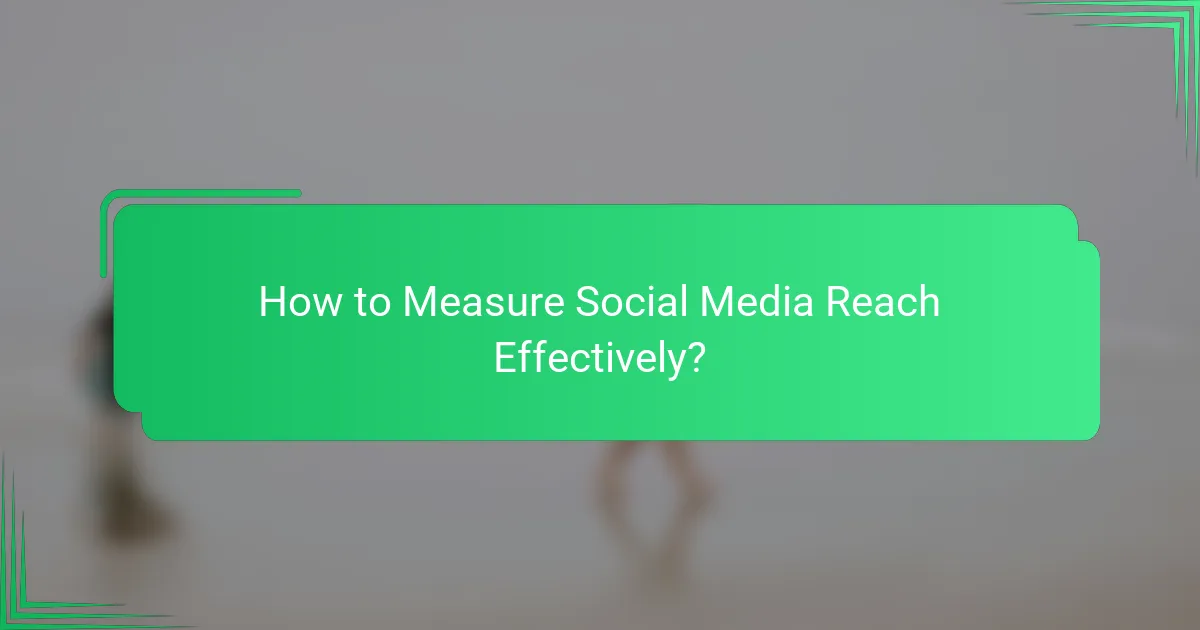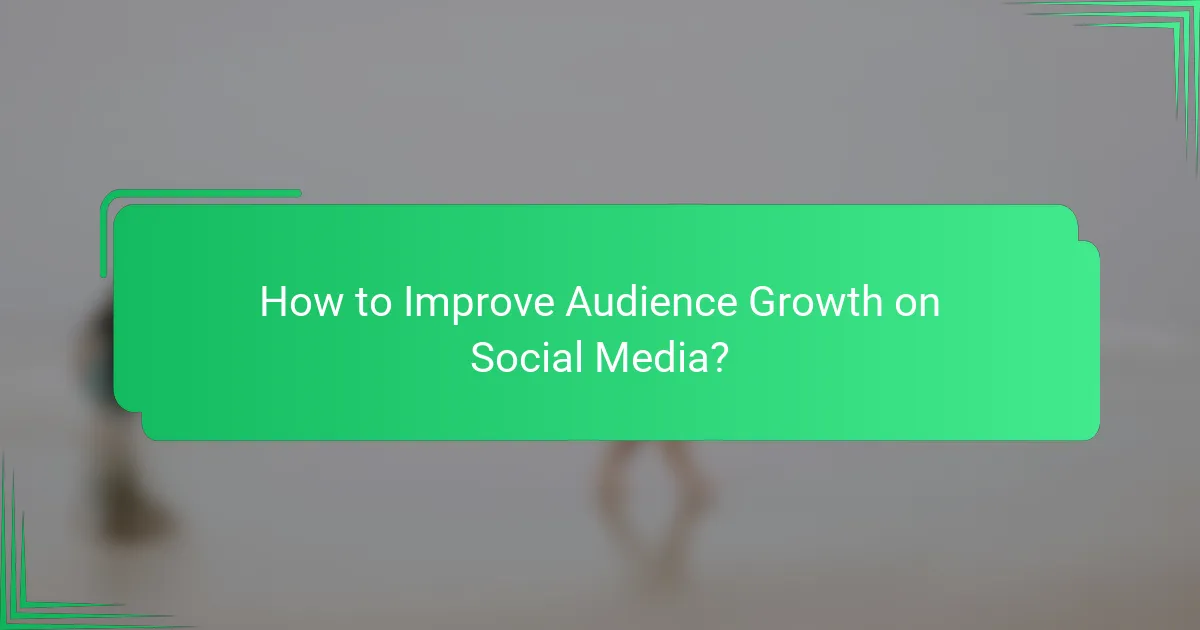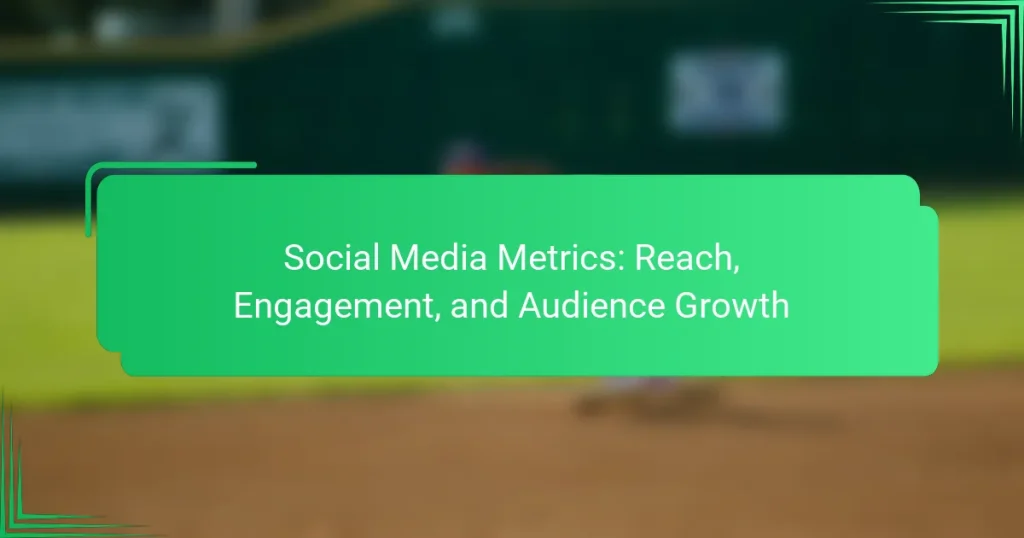Understanding social media metrics such as reach, engagement, and audience growth is vital for any successful online strategy. Reach measures the number of unique users who see your content, while engagement metrics reveal how well your posts resonate with your audience. By focusing on these metrics, businesses can refine their content strategies and foster meaningful connections with their followers.

How to Measure Social Media Reach Effectively?
Measuring social media reach involves assessing how many unique users see your content across various platforms. This metric is crucial for understanding the visibility of your posts and the effectiveness of your overall social media strategy.
Using Analytics Tools
Analytics tools are essential for tracking social media reach accurately. Platforms like Facebook Insights, Twitter Analytics, and Instagram Insights provide detailed reports on reach metrics, allowing you to analyze performance over time. Consider integrating third-party tools like Hootsuite or Sprout Social for a more comprehensive view across multiple channels.
When using these tools, focus on metrics such as total reach, organic reach, and paid reach to get a full picture. Regularly reviewing these analytics can help you identify trends and adjust your content strategy accordingly.
Understanding Impressions vs. Reach
Impressions and reach are often confused but represent different metrics. Reach refers to the number of unique users who see your content, while impressions count the total number of times your content is displayed, regardless of whether it was clicked or not. Understanding this distinction is vital for evaluating the effectiveness of your posts.
For example, if a post has a reach of 1,000 but 3,000 impressions, it means that some users saw the post multiple times. This can indicate strong engagement or the need for more diverse content to attract new viewers.
Setting Clear Goals
Establishing clear goals for your social media reach is critical for measuring success. Define what you want to achieve, whether it’s increasing brand awareness, driving traffic to your website, or boosting sales. Specific, measurable goals will help you focus your efforts and assess your progress.
For instance, aim to increase your reach by a certain percentage over a specific period, such as 20% in three months. Regularly evaluate your performance against these goals and adjust your strategies as needed to ensure continuous improvement.

What Are the Key Engagement Metrics?
Key engagement metrics are essential for evaluating the effectiveness of social media strategies. They provide insights into how well content resonates with the audience and can guide future marketing efforts.
Likes and Shares
Likes and shares are fundamental indicators of content appreciation and reach. A high number of likes suggests that the audience finds the content appealing, while shares extend its visibility to new users, amplifying its impact.
When analyzing likes and shares, consider the context of your audience. For example, a post with hundreds of likes but few shares may indicate that while the content is liked, it lacks the shareable quality that encourages users to spread it further.
Comments and Mentions
Comments and mentions provide deeper insights into audience engagement and sentiment. Comments reflect direct interaction and feedback, while mentions can indicate brand awareness and user discussions about your content.
Encourage comments by asking questions or prompting discussions. Monitor mentions across platforms to gauge brand perception and identify opportunities for engagement. A healthy balance of comments and mentions can signal a strong community connection.
Click-Through Rates
Click-through rates (CTR) measure the effectiveness of calls to action in your posts. A higher CTR indicates that your audience is motivated to take the next step, whether it’s visiting your website or engaging with additional content.
To improve CTR, ensure that your links are relevant and your calls to action are clear. A typical CTR for social media posts can range from 1% to 5%, but this can vary significantly based on industry and audience. Regularly analyze your CTR to refine your strategies and improve performance.

How to Improve Audience Growth on Social Media?
To enhance audience growth on social media, focus on creating engaging content, leveraging paid advertising, and collaborating with influencers. These strategies can significantly increase your visibility and attract new followers.
Content Strategy Optimization
Optimizing your content strategy involves tailoring your posts to resonate with your target audience. Analyze what types of content—such as videos, infographics, or articles—generate the most engagement and adjust your approach accordingly.
Consider using a content calendar to plan and schedule posts consistently. Aim for a mix of promotional and value-driven content to keep your audience engaged without overwhelming them with sales pitches.
Utilizing Paid Advertising
Paid advertising can effectively boost your audience growth by targeting specific demographics. Platforms like Facebook and Instagram offer robust targeting options, allowing you to reach users based on interests, behaviors, and location.
Set a budget that aligns with your goals, and monitor your ad performance regularly. A/B testing different ad formats and messages can help you determine what resonates best with your audience, optimizing your return on investment.
Collaborating with Influencers
Partnering with influencers can expand your reach and credibility. Choose influencers whose audience aligns with your target market, as their endorsement can attract new followers who trust their recommendations.
Establish clear objectives for the collaboration, whether it’s increasing brand awareness or driving traffic to your website. Consider offering incentives, such as affiliate commissions or exclusive discounts, to motivate influencers to promote your brand effectively.

What Frameworks Help Analyze Social Media Metrics?
Effective analysis of social media metrics relies on structured frameworks that provide clarity and direction. Two widely used frameworks are SMART Goals and SWOT Analysis, each offering unique insights into reach, engagement, and audience growth.
SMART Goals Framework
The SMART Goals Framework helps set specific, measurable, achievable, relevant, and time-bound objectives for social media campaigns. By clearly defining these goals, businesses can better track their performance and adjust strategies as needed.
For example, instead of a vague goal like “increase engagement,” a SMART goal would be “increase post engagement by 20% over the next three months.” This specificity allows for focused efforts and easier evaluation of success.
When implementing SMART goals, ensure that each goal aligns with your overall business objectives and is realistic given your resources. Regularly review and adjust these goals based on performance data to stay on track.
SWOT Analysis for Social Media
SWOT Analysis is a strategic tool that evaluates the strengths, weaknesses, opportunities, and threats related to social media efforts. This framework helps identify internal capabilities and external factors that can impact social media performance.
For instance, a strength might be a strong brand presence, while a weakness could be limited content creation resources. Opportunities may include emerging platforms or trends, whereas threats could involve changing algorithms or increased competition.
Conducting a SWOT analysis involves gathering input from various stakeholders and analyzing current metrics. This comprehensive view can guide strategic decisions and help prioritize actions that enhance reach and engagement.
![]()
What Tools Are Best for Tracking Social Media Metrics?
To effectively track social media metrics, tools that provide comprehensive analytics, website traffic insights, and engagement data are essential. The right tool can help you measure reach, engagement, and audience growth, enabling data-driven decisions for your social media strategy.
Hootsuite for Comprehensive Analytics
Hootsuite offers a robust platform for tracking various social media metrics across multiple channels. It provides detailed reports on reach, impressions, and engagement rates, allowing users to analyze performance trends over time.
One of the key features is its customizable dashboards, which let you focus on the metrics that matter most to your business. You can set up alerts for significant changes in engagement or follower growth, ensuring you stay informed about your social media performance.
Google Analytics for Website Traffic
Google Analytics is invaluable for understanding how social media drives traffic to your website. By linking your social media accounts, you can track user behavior and conversions originating from different platforms.
Utilize UTM parameters to tag your social media links, which will help you identify which posts or campaigns generate the most traffic. This insight allows you to optimize your content strategy based on actual user interactions.
Sprout Social for Engagement Insights
Sprout Social specializes in providing deep insights into audience engagement. Its analytics tools help you measure how users interact with your content, including likes, shares, and comments.
With features like sentiment analysis, you can gauge audience reactions and adjust your messaging accordingly. Sprout Social also offers competitive analysis, allowing you to benchmark your performance against industry standards and identify areas for improvement.
